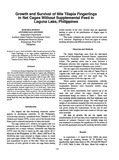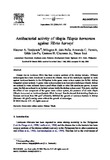Growth and survival of Nile tilapia fingerlings in net cages without supplemental feed in Laguna Lake, Philippines
- Global styles
- MLA
- Vancouver
- Elsevier - Harvard
- APA
- Help
Share
Abstract
Oreochromis niloticus fingerlings were stocked at densities of 50, 100, 150 and 200 fish/m super(2) in fixed net cages in Laguna Lake, Philippines. These were reared without supplemental feed on 1 April-30 July 1980, 5 August-3 December 1980, and 19 December 1980-19 April 1981. Water temperature, dissolved oxygen, chloride level and pH for the three periods were measured outside the net cages. Growth rates were highest at 50 and 100 fish/m super(2) reared between April and July when phytoplankton biomass was high with a peak production observed in June (65.5 g/m super(2)), and zooplankton biomass ranged from 9.3 to 32.68 g/m super(2). Under these conditions, fish initially weighing 1.6-1.7 g grew to a marketable size of 106-124 g in four months. Those stocked at 150 and 200 fish/m super(2) had lower weights but still weighed over 80 g. None of those in the other two rearing periods exceeded 50 g after four months. Survival and fish yield during April-July were also higher than for those reared during the other periods.
Suggested Citation
Basiao, Z., & San Antonio, A. (1986). Growth and survival of Nile tilapia fingerlings in net cages without supplemental feed in Laguna Lake, Philippines. In J. L. Maclean, L. B. Dizon, & L. V. Hosillos (Eds.), The First Asian Fisheries Forum: proceedings of the First Asian Fisheries Forum, Manila, Philippines, 26-31 May 1986 (pp. 533-538). Manila, Philippines: Asian Fisheries Society.
Type
Conference paperKoleksi
- Conference Proceedings [298]
Related items
Showing items related by title, author, creator and subject.
-
Vibrio load and percentage composition of sucrose‐fermenting vibrios in Nile tilapia (Oreochromis niloticus) cultured in brackish water earthen ponds and biocontrol potential of recycled tilapia‐conditioned greenwater against population growth of V. parahaemolyticus and non‐sucrose‐fermenting vibrios in the grow‐out culture of white leg shrimp (Litopenaeus vannamei)
Pakingking, Rolando V., Jr. ; Palma, Peter
; Palma, Peter  ; de Jesus-Ayson, Evelyn Grace T.; Usero, Roselyn
; de Jesus-Ayson, Evelyn Grace T.; Usero, Roselyn  (Wiley, 2022-10-20)
Vibrio are known opportunistic pathogens of pond-cultured fish and shrimp. This study determined the presumptive Vibrio count (PVC) and percentage composition of “beneficial” sucrose-fermenting vibrios (SFVs) ...22 Total citations2 Recent citations0.86 Field Citation Ration/a Relative Citation Ratio
(Wiley, 2022-10-20)
Vibrio are known opportunistic pathogens of pond-cultured fish and shrimp. This study determined the presumptive Vibrio count (PVC) and percentage composition of “beneficial” sucrose-fermenting vibrios (SFVs) ...22 Total citations2 Recent citations0.86 Field Citation Ration/a Relative Citation Ratio -
Antibacterial activity of tilapia Tilapia hornorum against Vibrio harveyi
Tendencia, Eleonor ; dela Peña, Milagros R.; Fermin, Armando C.; Lio-Po, Gilda; Choresca, Casiano H., Jr.; Inui, Yasuo (Elsevier, 2004)
Disease due to luminous Vibrio has been a major problem of the shrimp industry. Different technologies have been introduced to control the disease. One of the techniques reported to work against luminous bacteria in the ...3636 Total citations3 Recent citations2.99 Field Citation Ration/a Relative Citation Ratio
; dela Peña, Milagros R.; Fermin, Armando C.; Lio-Po, Gilda; Choresca, Casiano H., Jr.; Inui, Yasuo (Elsevier, 2004)
Disease due to luminous Vibrio has been a major problem of the shrimp industry. Different technologies have been introduced to control the disease. One of the techniques reported to work against luminous bacteria in the ...3636 Total citations3 Recent citations2.99 Field Citation Ration/a Relative Citation Ratio -
Effect of shrimp biomass and feeding on the anti-Vibrio harveyi activity of Tilapia sp. in a simulated shrimp–tilapia polyculture system
The efficiency of Tilapia hornorum to control luminous bacteria in a simulated shrimp farm environment has been reported. However, the effects of different factors such as feed input and the shrimp biomass were not taken ...1212 Total citations3 Recent citations1.03 Field Citation Ration/a Relative Citation Ratio





